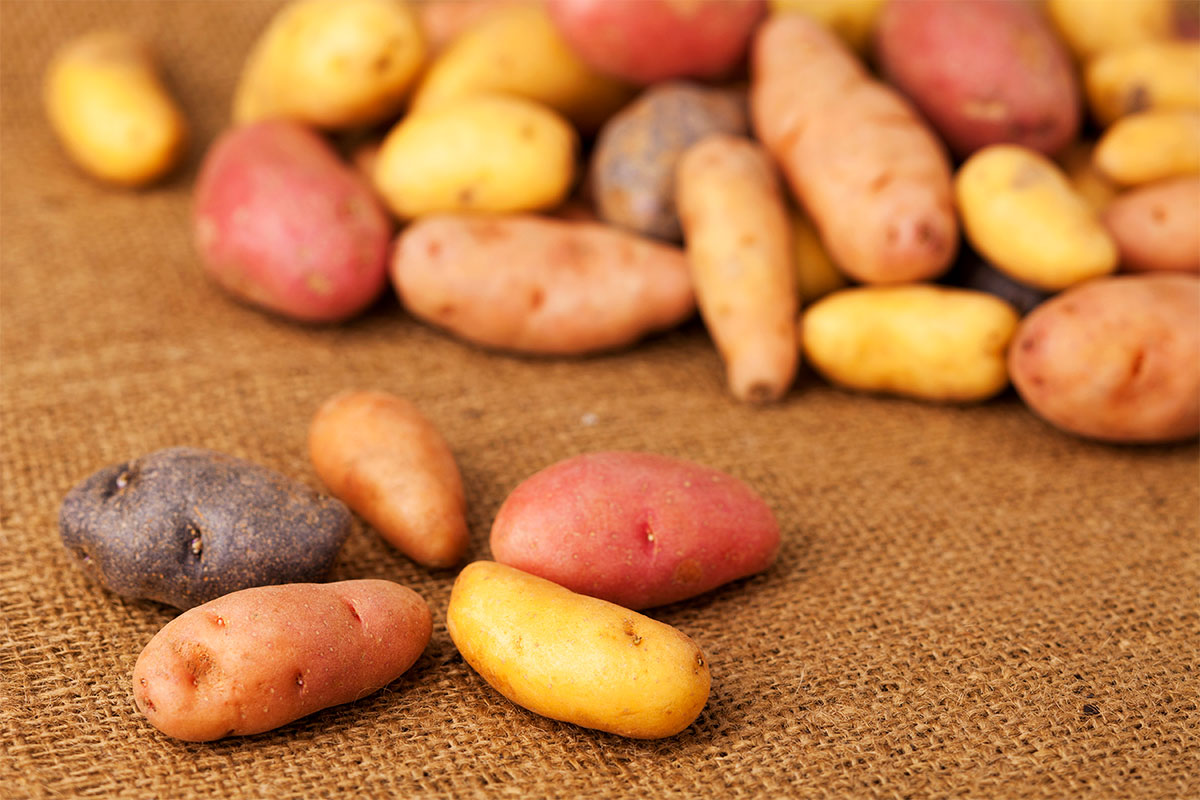Fingerling potatoes are small, stubby, long potatoes, which can be one of a variety of heirloom potato cultivars. These potatoes should not be confused with new potatoes- they are bred to be small and long when full mature.

About Fingerling Potatoes and Fingerling Varieties
Potatoes have a wide variety of size, shape, and taste, and those variations in flesh, color, flavor, and shape make for wide differences in how fingerlings are prepared. The range of variety is remarkable, and the flesh of a specialty potato can range from pale yellow to deep purple, flavors from nutty to buttery, and texture from waxy to smooth – making it possible to find just the right look and taste for any gourmet potato dish. Read about the key differences in the varieties Greater Tater grows and provides to foodservice vendors.
This is the most popular of all of the fingerling potato varieties. This variety has a skin that is tan colored, waxy, and smooth. This loved potato has a fluffy yellow tinted flesh with a nutty and buttery flavor.
Austrian Crescents have a smooth, yellow to tan skin and light yellow flesh. A firm and waxy tuber with a straight to crescent shape.
This variety boasts a uniquely nutty flavor and has a smooth, buttery texture with hints of hazelnuts and chestnuts. The La Ratte fingerling originated in Europe in the late 19th century.
Purple Peruvians have dark purple, ink-colored skin and flesh. Their coloring can be opaque or marble throughout the flesh. Purple potatoes are usually dry, starchy, earthy and sport a slightly nutty flavor.
This favorite variety offers a slightly more knobby look than the popular Russian Banana. Its pinkish/tan skin conceals a firm, waxy yellowish flesh.
Chilean Red is a popular variety from South American. Chileans grow very elongated tubers with and have dark red skin and white to pink flesh.
The skin of this smooth, brightly colored pink/red fingerling conceals a fluffy and pink flesh. A fine tasting member of our family of products.
More round than many fingerlings, this varietys smooth and shiny pink to red skin and has a dry, fluffier yellow flesh with streaks of reddish pink. It offers a creamy texture and slightly nutty flavor.
These earthy-flavored potatoes are purple all the way through with violet to wine-colored skins and succulent purple flesh.
Growing 3 Types of Fingerling Potatoes
FAQ
What is another name for fingerling potatoes?
Are fingerling potatoes similar to Yukon Gold?
What is a substitute for fingerling potatoes?
Are fingerling potatoes just baby potatoes?
What is a fingerling potato?
Also known as fingerling potatoes. Like many potatoes, fingerling potatoes are baked, boiled, fried, steamed as a side dish and are also used in salads. Choose firm and thick potato shoots that have wrinkled skin, avoid eye sprouts, soft spots, blemishes and green spots. Store potatoes in a cool dry place.
What else is mallet finger called?
The thin tendon that straightens the end joint of a finger or thumb is injured in mallet finger. Although it is often known as “baseball finger,” this injury can occur to anybody when an unyielding item (such as a ball) contacts the tip of a finger or thumb, forcing it to bend farther than it was designed to go.
How to choose the best fingerling potatoes?
To choose top-quality fingerling potatoes, go for smooth, firm ones. You should also avoid those with: As fingerlings are dug up from the ground, it’s natural for the potato skins to be covered with dirt. If you’re looking for fresh produce delivery, you can easily shop for fingerling potatoes via Instacart.
What does A fingerling potato look like?
They also tend to be elongated and slightly knobbly, making them very finger-like in shape. The unusual looking, flavorful potatoes can be used just like regular potatoes in an assortment of roasted, broiled, baked, grilled, or boiled dishes. Many grocers stock fingerlings in season, and they can also be grown at home, in temperate climates.
